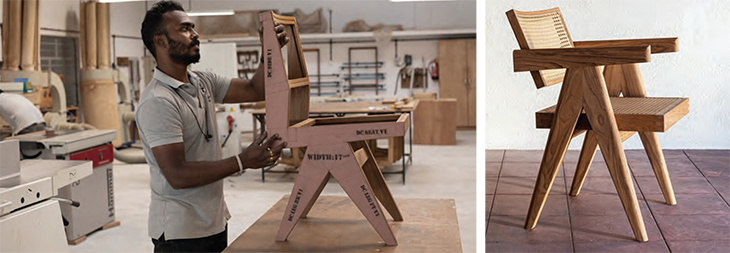PHANTOM HANDS
This Bengaluru-based furniture manufacturer has come a long way since it went into production in 2014, with its products now exported to 25 countries. Its founder, Deepak Srinath, takes us on his journey from an IT ‘techie’ to woodworker with an international following.

A template (L) lends itself to making a fine-finished V-legged iteration (R) of the ‘Chandigarh Chair’.
When Deepak – a B.Tech in Computer Science from Bengaluru – took up hunting for vintage artefacts as a hobby in early 2010, little did he realise that it would soon become a passion that would end up in the setting up of his own workshop to make hand-crafted furniture, based on post-Independence Indian Modernist designs.
After a 5-year stint in the UK with an IT firm, he returned to India to set up a boutique investment bank and helped fund startups in the tech sector for 8 years. In his spare time, he travelled across South India with his artist wife, Aparna Rao, where vintage books, furniture and artefacts caught his fancy.
Soon the hobby turned into a regular, monthly newsletter to his friends and fans, in India and abroad, featuring curated pieces of old furniture and their descriptions. Deepak named the newsletter ‘Phantom Hands’, a metaphor for the generations of artisans whose contributions manifest in the furniture and artefacts he curated.
The newsletter (and later the website) drew such widespread interest that Deepak began identifying, buying, restoring and selling pieces of vintage furniture and artefacts with the help of a carpenter in his home garage.
By 2014, Deepak had realised that the hustle of business valuations and funding, mergers and acquisitions, and poring over XL spreadsheets had never been a good fit for him. But he also realised that getting into vintage furniture, with its niche market, was a very expensive proposition. It was then that he chanced upon some chairs that traced their provenance to the ‘Chandigarh Collective’.

Phantom Hands founder Deepak Srinath has grown his brand with the help of Instagram and international design collaborations.
Modern legacy
He painstakingly researched the building of Chandigarh as India’s first planned city after Independence – later turning into the joint capital of Punjab and Haryana – in the 1950s and ‘60s that left behind several legacies in architecture, urban design and planning.
A Swiss architect-designer, Pierre Jeanneret – a cousin of Chandigarh’s main architect, Le Corbusier – left behind another important legacy of minimalist, simple and easy-to-make furniture designs that would populate the offices and homes of Chandigarh for decades to come!
Deepak calls it “India’s first post-Independence modern furniture” and the copyright-free templates the “world’s first open-source furniture design project”. Pierre and his team made public hundreds of furniture designs and templates – drawing from French Modernist influences – to enable several furniture manufacturers across the region.
These were manufactured in several iterations – often not very expertly! – to help furnish the emerging buildings and growing people’s needs of a newly born city. These designs were imbued in the furniture of the ‘Chandigarh Collective’ era, characterised by the inverted ‘V’ and ‘X’ legs of chairs and tables. With time, however, this design language was replaced by the Godrej style of office furniture and storage.
In the early 2000s, some French art collectors happened to salvage and ship large consignments of this junked furniture, before public outrage over Chandigarh’s “stolen legacy” put a halt to the exodus. Many of these furniture pieces were expertly restored as ‘Chandigarh chairs’ and found big buyers at auctions in Europe.
Deepak’s website on vintage furniture also drew attention from across the world. Catching up with their popularity faster than expected, he noted that there were fake replicas of the “vintage” Chandigarh chairs flooding international markets, with merchandisers making a fast buck.

A Kangaroo chair from the Chandigarh Collective (extreme left), gives company to a contemporary coffee table from the X+L collaboration. The Tangali bench (right) with cane wrap-around cane weave comes from Milan design duo I+S.
Reclaimed wood
All of this got Deepak thinking: why not make genuine re-iterations of these chairs and tables, and sell them at a reasonable price to those that fancied them? This would also give him an opportunity to engage the services and talents of traditional Indian carpenters and joiners that he had seen on his excursions.
Since 2014, Deepak had been conducting research to ascertain the copyright of these ‘Chandigarh chairs’. With no impediments on that front, he had been making financial contributions to help the Canadian Centre for Architecture, the repository of Pierre Jeanneret’s legacy, to help digitise his archives and make them accessible through the Centre’s website.
When the time came to take the plunge, Deepak had no idea of furniture manufacturing – needless to say. But he roped in his father-in-law,
Sumanth Rao, a popular furniture maker in Bengaluru in the 1980-90s, to help. With the latter’s assistance and industry connections, Phantom Hands was launched in 2015 as a workshop that produced three sets of ‘Chandigarh chair’ designs.
The first batch was made from teak rafters salvaged from a part of a demolished auditorium of Bengaluru’s well-known Bishop Cotton’s Boys’ School. As word got out, school alumnus and Infosys family member, Rohan Murty, emerged among the first buyers of the furniture.
But the real growth came from international markets, through the website and Deepak’s Instagram account of his furniture pieces! From a shed making five chairs a month, Phantom Hands very soon grew to deliver up to 70 pieces of furniture for a British architect’s club project. The architect visited the workshop, understood the design language and Deepak’s ethos, before signing up.
Today, its collections include re-editions of mid-century classics and contemporary furniture designs that have resulted from several collaborations with internationally renowned design houses and architectural firms.
Wood matters
Deepak feels that this new exposure to design and manufacturing is more tangible than the hustle of his previous business ventures. But learning about wood was an “evolution”.
His technical advisor and father-in-law ran him through the nature and vagaries of wood – from its elasticity and strength to expansion-contraction, moisture behaviour and bending. “It is a continuous learning process,” he admits.
“In the UK, it is customary to talk about the (unpredictable) weather whenever you meet someone. At Phantom Hands we exchange notes and information each day about wood behaviour,” Deepak remarks.
Wood seasoning and moisture was a matter of immediate concern. Reclaimed wood had none of these issues, Deepak recalls, but its supply was increasingly scarce and erratic. While the supply lasted, Burma (Myanmar) teak was a welcome material to work with – but its availability and legality was becoming increasingly difficult and suspect.
That’s when Indian teak (Tectona grandis) made its mark on Deepak. Coming from legal sources (the forest departments of Maharashtra and Madhya Pradesh), with its open-air seasoning, inborn resistance to insect and fungal infections, and its beautiful grain patterns, teak remains his favourite.
He has some notes of caution though: not all teak that is passed as teak by timber merchants is teak… If the price is too good to be true, beware! Not all timber is uniformly dried in kilns. Not all seasoning is done in a scientific manner. And watch out for camouflaged defects in the sawn wood that you ordered.
Of late Phantom Hands has tried experimental production with North American hardwood species. Their life cycle assessment, sustainable harvest, carbon footprint and transparent chain of custody have left Deepak impressed. His recent project with the American Hardwood Export Council (AHEC) and an Australian designer has left him satisfied. (Read WoodNews, Nov-Dec 2024).
Trainee, trainer
Phantom Hands has now grown into a 1,500-square-metre factory. It has 120 employees, experts in carpentry and cane weaving, upholstery and polishing. Carpenters come from Rajasthan, Uttar Pradesh, Bihar and Kerala, and cane weavers from Tamil Nadu, West Bengal and Karnataka.
They come with traditional knowledge and artisan skills; but it is the younger (less experienced) hires that are most excited to experiment, Deepak notes. That has helped Phantom Hands exercise design rigour, establish processes in production, ensure tighter quality control in manufacturing, and an open mind to collaborations.
The hierarchy, as in most woodworking entities in India, follows the
guru-shishya concept: “star” carpenters lead collaborations and innovation, followed by those in the learning stage. A hire with more than 5 years’ experience trains under his ustaad for at least a year; newcomers take up to 5 years to graduate to ‘star’ status among carpenters, polishers and weavers.
Except for machine operators and polishers, they all prefer to sit on the floor, using their hands and feet as they work wood pieces to perfection!
Factory hardware
True to the ethos of specialising in hand-crafted furniture at Phantom Hands, Deepak has stayed off CNC machinery in his factory. He employs classical woodworking machines, including from the Italian SCM and Austrian Felder groups. These comprise of circular, band and radial-arm saws; thicknessers, belt sanders and spindle moulders; and a Panto router for mortise-and-tenon duties.
The carpenters mainly use jigs; but for bending wood, Deepak recently acquired a vacuum press from the UK.
Phantom Hands uses Mirka hand sanders and polishers from its Indian subsidiary; Italy’s Renner for paints; Sirca coatings and stains from Italy; organic wax oils/ shellac from Kenho-Lacke GmbH of Germany and Protego of Denmark.
There are sewing and overlocking machines and stapling systems in place for upholstery. The brand does not use machine-made or pre-woven cane. It is sourced from North-East India; and skilled cane weavers at Phantom Hands work magic with ‘on-the-frame’ furniture pieces.

Carpenters and weavers prefer to sit on the floor, using their hands and feet as they work wood pieces to perfection (L). An apprenticeship at Phantom Hands (R) can last 5 years.
Why collaborations?
Phantom Hands exports its products to (in that order of volume) to China, Japan, Taiwan, the US and Western Europe. It has representatives in the form of furniture gallery owners in Japan, South Korea, China, Taiwan, Hong Kong, Singapore, Indonesia, the US, Italy, Belgium, Germany, the Netherlands, Switzerland, Norway, Poland – even Brazil and the Dominican Republic.
In India, the brand is represented by Le Mill (Mumbai) and Room Collective Therapy in Hyderabad. Though it has executed some hospitality projects in Dubai, Qatar and Europe, its mainstay is home furniture. For that Deepak relies on architects and interior designers as key influencers.
What attracts them to his furniture? Deepak feels it is the modern, yet simple, Indian design language, re-iterations of classical and period furniture, and appreciation for the quality and value of Indian hand-crafted products.
So far Phantom Hands has had on-site (in the Bengaluru factory) interactions with several internationally renowned designers, architects and fabric specialists. “These exchanges are on an equal footing. Phantom Hands is not a service provider but an equal partner,” Deepak explains. “All our collaborations involve exclusive licences to Phantom Hands to manufacture under our own brand name.”
Each collaborator has his/her own design language and sensibility, honed by years of practice. “We marry our craft possibilities with the designer’s vocabulary and expertise,” says Deepak.
Moreover, most of these designers and architects are already well-known. So, market interest develops with each collaboration, Deepak says, adding: “Many more architects start following our interactions and the results.”
So far Phantom Hands has collaborated with Milan-based (Kyoko) Inoda and (Nils) Sveje architect duo; X+L (Xander Vervoort and Leon van Boxtel) from Amsterdam; German designer Klemens Grund; Swiss designers Big-Game Studio; and Scottish designer Derek Welsh.
The brand has also roped in Nityan Unnikrishnan, a Goa-based furniture maker, resulting in (among others) the ‘Palakkad chair’. Padmaja Krishnan from Mumbai and Bengaluru’s Ravi Khemka have collaborated for exclusive upholstery.
“What next?” I ask Deepak. Phantom Hands has recently acquired a licence to manufacture 20 models of furniture from the late Sri Lankan architect, Geoffrey Bawa’s design portfolio. I and the world of craft furniture look forward to it this year!
Comments

- In Silver Jubilee year, propelling growth remains the ‘mantra’
- PHANTOM HANDS
- ‘Fevicol Pro series is disruptive innovation’
- Furtech Show 2025 returns to Dubai in September
- Vert: the red-oak route to a cool-cool city
- Moisture? Measure twice, cut once!
- ‘Mirka has solutions for today, tomorrow, thereafter’
- On 50th anniversary, Ligna has more on offer
- Ukrainian designer redefines function through form
- New technology holds key to plywood industry survival
- Light on solid wood’s role in neuro-diverse spaces
- Evolving furniture demands require ace tooling
- Interzum 2025: rethinking resources
- CIFF Guangzhou opens in March in two phases
- Feria Hábitat València to expand into design
- WOFX 2024 was an unprecedented success
- HIFF 2025 promises to be bigger, better
- Event-Calendar
- Hettich’s ‘Magic lights’ are sheer brilliance
- Blum’s Revego systems for new space concepts
- Häfele’s MatrixBox combines functionality, sophistication
- How Protego’s oils protect exterior woodwork
- Ineos adds new ABS grade
- 2025 outlook for laminate industry
- A functional masterpiece of garden architecture
- European symposium highlights formaldehyde emission limits
- Egger adopts holistic approach to waste management
- Role of PUR adhesives in flat lamination
- Weber machines dovetail into best practices
- Hymmen’s smart2i facilitates digitally mapping production
- Schmalz compact ejectors lead ‘green’ automation
- Arnavi introduces Rema FX 250 table saw
- HAKS helps with design, tech, training
- Transforming woodworking with precision and efficiency
- ‘Cannot miss’: IWMMTA programme for industry
- Premium woodworking machinery from Jai
- High-tech drilling machine, planer sander from Woodtech
- Innovation defines Turakhia products
- Intelligent door production lines from Aadhunik
- Aryamman introduces two exquisite new décors
- Biesse’s Rover Edge revolutionises edge banding
- Check out versatile, durable Canadian wood species
- Expert slide machinery manufacturer from Taiwan
- Ebco to unveil more functional fittings
- Felder to showcase its range of woodworking machinery
- Frontaline has honeycomb core for shutters
- Holytek remains finger-jointing champion
- Homag to showcase its latest innovations
- ICA Pidilite: defining the future of wood coatings
- Innovator’s veneer splicers are UltiMate
- Premium quality steel belts from IPCO
- Precision solutions from Jacinth Machineries
- UV flatbed printers for furniture, interiors
- NextGen sanding tools from Mirka
- Pro-grade edge bander from OAV
- Check out the new Ornare ‘Surface’ range
- AM15K laminates meet new design challenges
- Richfill calibrated filler solves multiple problems
- SCM to present cutting-edge technologies
- Double-side tenoners, profilers from Technik
- Weinig’s Timbermat 5 is versatile planer, moulder
- Woodmaster’s machines ensure precision and efficiency
- Dieffenbacher’s ‘Osiris’ set to revolutionise fibreboard recycling
- Ebco Led lighting feature
- Jovas Tech Solutions – Redefining Woodworking Technology in India
- ITP: Crafting Excellence, Transforming Spaces
- “Greenlam Studio opens in Nashik”
- Dew River Group: Innovating Sustainable Wood Solutions
- Woodtech: Pioneering Advanced Woodworking Solutions in India




































